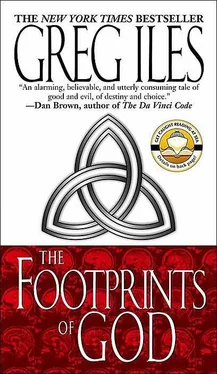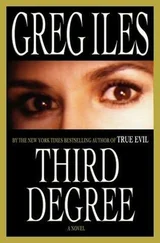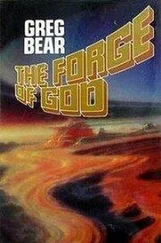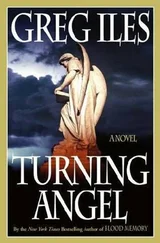"Do you recognize anything from your dreams?" Rachel asked.
"No. Let's go."
Ibrahim led us along a cobbled street, weaving through the tourists with practiced ease. I had expected to find reverence here, but the atmosphere was more like a circus. A babel of voices reverberated between the walls: German, French, English, Russian, Hebrew, Arabic, Japanese, and Italian, and those just the languages I recognized. A man with a crew cut and an Alabama accent preached fire and brimstone to a group of Japanese pilgrims. Ibrahim talked all the way, his spiel honed to an emotionless monotone over years of guiding.
"Wait," Rachel said, stopping him. She turned to me. "What do you want to see?" "Where are we?"
Ibrahim smiled. "Sir, up there at the blue door is the Omaria School, site of the first station of the cross, where Jesus was condemned to death."
"Do you want to see that?" Rachel asked.
"No. What's the second station?"
Ibrahim pointed down the cobbled street to a half cir¬cle of bricks set in the street. "There is where Jesus began to carry the cross. Down the street is the Chapel of Flagellation, where the Roman soldiers whipped Jesus, set on him a crown of thorns, and said, 'Hail, King of the Jews!' Then Pilate led him to the crowd and cried, 'Ecce homo! Behold the man!'"
Ibrahim delivered this information with the excitement of a man reading bingo numbers in a nursing home.
"Go on," I said. "To the church."
Our guide continued down the street. We passed a black door set in a white stone arch, and Ibrahim said something about Jesus falling for the first time. I stared at the door but felt nothing. Perhaps what I sought lay buried beneath this warren of streets and shops and awnings. Jerusalem was probably like Cairo, built upon its own bones, a place where any new construction unearthed lost chapters of history.
Ibrahim led us to another semicircle of bricks and started his spiel again. "This is the fifth station, where the Romans soldiers compelled Simon of Cyrene to help Jesus carry the cross."
Rachel glanced at me. "Keep moving."
A smiling boy wandered by selling thorn crowns. He took my stare as a sign of interest, but Ibrahim shooed him away. As I watched the bundle of thorns bob down the street on the boy's arm, blackness filled my vision, and my knees went to water. Rachel slipped under my right arm, and together we stumbled after Ibrahim.
The next few stops were a blur, the Palestinian's words blending in a rush of strange images: Here Veronica wiped Jesus' tormented face, at which his true likeness was miraculously imprinted on the veil… here Jesus fell the second time… here he said, "Daughters of Jerusalem, do not weep for me, but weep for yourselves and for your children"…
We passed over a rooftop and through a dark chapel, and then I found myself in a crowded courtyard before a Romanesque church. Pilgrims, priests, and nuns moved under the watchful eyes of a dozen Israeli soldiers with submachine guns.
"This is Church of the Holy Sepulchre," Ibrahim said, waving his arm toward the building. "Built by Crusaders over fifty years between 1099 and 1149. Original basilica was built by Queen Helena, mother of Constantine, who came here in 325 and discovered pieces of the true cross in cave below the earth."
I looked with dismay at the line of tourists before the door.
"This not bad," Ibrahim said. "Tourism very bad for this time of year. The fighting scare everyone away, even in Western Holy Week. Good for you, bad for me. Do you feel all right, sir? I could get you some water while we wait."
"I'm fine."
"You can put more weight on me," Rachel said, repo¬sitioning herself under my arm.
I leaned a little harder on her. "Thanks."
She touched my cheek with the back of her hand. "I wish I could take your blood pressure."
"To the right of the entrance is tenth station," said Ibra¬him. "There Jesus was stripped of his clothes. Last five sta¬tions of the cross are contained within the church itself."
"It's strange, isn't it?" Rachel said quietly. "Millions of people traveling to see an empty tomb?"
All I could manage was a nod.
"This is only empty tomb in any Christian church on earth," said Ibrahim. "The angel asked the Marys, 'Whom do you seek?' 'Jesus of Nazareth,' they said. 'He is not here,' said the angel. 'He is risen.'"
The courtyard suddenly faded before me, and my limbs grew less heavy. I seemed to float on Rachel's arm.
"David?" she asked. "Can you hear me?"
I blinked and found myself looking at a stone ceiling. "Are we inside the church?"
"You were sleepwalking," she whispered, her eyes filled with anxiety. "We have to get you back to the hotel."
"We're here now. We made it. I have to see it."
"See what?"
And then I knew. "The tomb."
She turned to Ibrahim. "Where is Jesus' tomb?"
"This way. All the sites close together in this church." He pointed at a reddish marble slab on the floor. Several men and women in street clothes knelt with their faces pressed to the stone. Above them, a woman poured something on the slab. A sickly sweet wave of perfume hit me.
"What's that?" I asked.
"The Stone of Unction," said Ibrahim, "where Jesus' body was anointed with oils and wrapped in a shroud after he was taken down from the cross."
I moved closer, but I felt nothing. "Is this the original stone?"
"No, sir. This stone dates from 1810 and replaces stone from twelfth century. Nothing certain is known beyond that time. This way, sir."
He led us to the left, into the rotunda of the church. Light cascaded down from a spectacular gold and white dome. Below the dome stood a large rectangular edifice of marble that seemed to have been boxed for shipping in great metal bands. It was topped by a cupola that looked like it belonged on the Kremlin.
"What's that?" I asked.
"This is the Holy Tomb, sir. Called the Edicule, or lit¬tle house. Because Jesus was very important man, Byzantines and Crusaders spent a lot of money to make this tomb for him. It is fourteenth and final station of the cross. By the customs of Jews, always they buried the people outside the city. The present marble exterior is disintegrating and must be held together by iron bands. Come, sir? Get in the line? Madam?"
Ibrahim continued his unrelenting recitation, but I was too disoriented to process it. I'd expected the tomb of Jesus to be a cave of some kind, situated in an open place, not this mausoleum in a dungeonlike medieval church.
"The line's moving," Rachel said, helping me forward.
Soon we were standing before the door of the Edicule. Here Ibrahim spoke with the respect I had expected from the beginning.
"Inside the tomb we will see two rooms. Let us go in now."
In the first room I saw a podium with a glass case atop it. Inside the case lay a piece of stone.
"This we call the room of the angel," said Ibrahim. "Where the dead person wait until they prepare place to bury him. Here is kept a piece of the rolling stone where angels opened the tomb and Jesus raised up from the dead."
I noticed two holes in the wall to my right. Ibrahim said, "When the people have no fire for their Easter can¬dles, the priest he stand here and give them from the Holy Fire, gives light from his big candle to theirs."
My attention had been drawn to a low door in the thick marble wall of the inner tomb. I stooped and moved through the door into a small inner chamber. A man and woman knelt in prayer before what appeared to be a marble altar slab. They had placed crucifixes on the stone, as though the objects would be blessed by contact. Above them hung ornate silver lamps on chains, and everywhere burning candles threw flickering light around the room. Vases of white roses scented the air, their odor cloying in the small space.
Читать дальше












